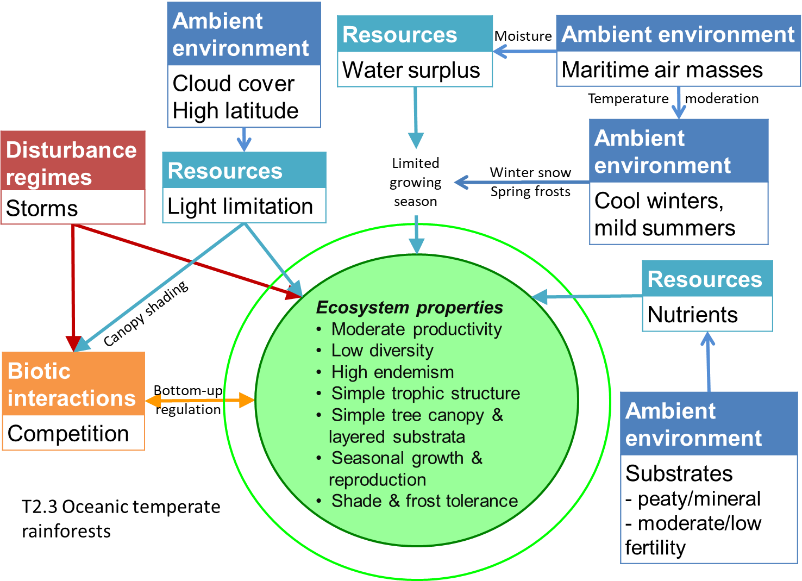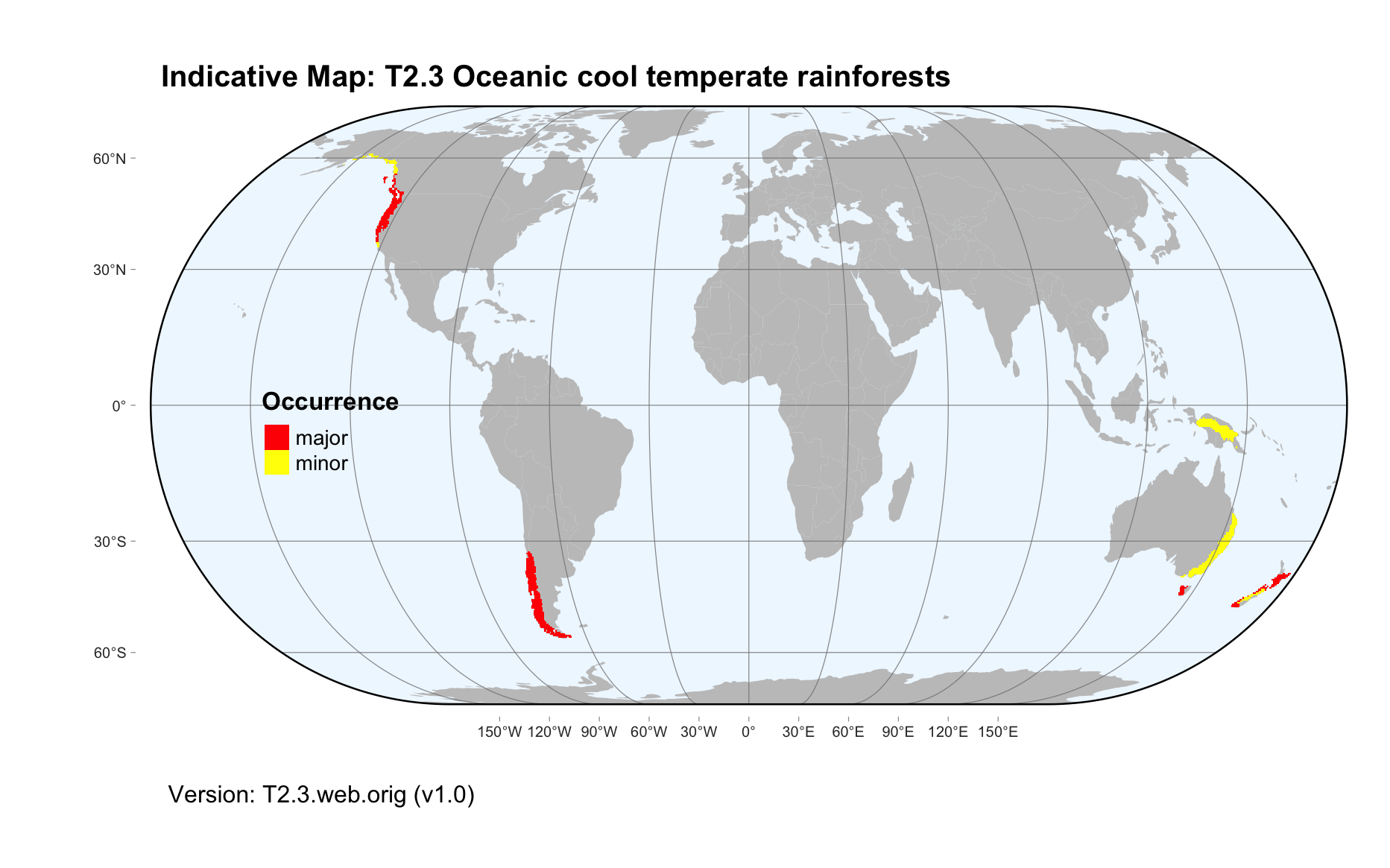Global ecosystem typology
Alternative site for the Global ecosystem typology with additional information for ecosystem profiles and indicative maps.
This site is maintained by jrfep
T2.3 Oceanic cool temperate rainforests
Biome: T2. Temperate-boreal forests and woodlands biome
Contributors:
(texts)
Oceanic cool temperate rainforests have evergreen or semi-deciduous, small-leaved trees, with conifers in some regions. These forests occupy a cooler, wetter climate than warm temperate forests (T2.4), but ocean influence promotes very high precipitation and limits persistence of winter snow (compared with T2.1 or T2.2). Tree diversity is low, but abundant epiphytic and terrestrial mosses and liverworts, ferns, lichens, and conspicuous fungi contribute to seasonal productivity. Foodwebs are simple, with low vertebrate diversity and fewer large herbivores and predators than T2.1 and T2.2, but with many species found nowhere else.
Key Features
Closed canopy evergreen or semi-deciduous forests in cool wet climates, high endemism with low tree diversity and abundant epiphytes.
Overview of distribution
Cool temperate coasts of Chile, Patagonia, New Zealand, Tasmania and Pacific Northwest.
Profile versions
- v1.0 (2020-01-20): DA Keith; SK Wiser; NA Brummitt; F Essl; D Faber-Langendoen
- v2.0 (2020-05-31): DA Keith; SK Wiser; N Brummit; F Essl; MS McGlone; D Faber-Langendoen
- v2.01 ():
- v2.1 (2022-04-06): DA Keith; SK Wiser; N Brummit; F Essl; MS McGlone; D Faber-Langendoen Full profile available at official site
Main references
Selected references for this functional group:
DallaSala DA, Alaback P, Spribille T, von Wehrden H, Nauman RS (2011) Just what are temperate and boreal rainforests? Temperate and boreal rainforests of the world: ecology and conservation (Ed. DA DellaSala), pp1-41. Island Press, Washington DC
McGlone MS, Buitenwerf R, Richardson SJ (2016) The formation of the oceanic temperate forests of New Zealand New Zealand Journal of Botany 54:128-155
McGlone MS, Lusk CH, Armesto JJ (2016) Biogeography and ecology of south-temperate forests New Zealand Journal of Botany 54: 94-99
Diagrammatic assembly model

Maps
Maps are indicative of global distribution patterns are not intended to represent fine-scale patterns. The maps show areas of the world containing major (coloured red) or minor occurrences (coloured yellow) of each ecosystem functional group. See general notes on maps.
There are 2 alternative versions of the indicative map for this functional group, please compare description and sources below.
T2.3.IM.orig_v1.0
Datasets
- Resolve-Ecoregions-2017
Map references
Dinerstein E, Olson D, Joshi A, Vynne C, Burgess ND, Wikramanayake E, Hahn N, Palminteri S, Hedao P, Noss R, Hansen M, Locke H, Ellis EE, Jones B, Barber CV, Hayes R, Kormos C, Martin V, Crist E, Sechrest W, Price L, Baillie JEM, Weeden D, Suckling K, Davis C, Sizer N, Moore R, Thau D, Birch T, Potapov P, Turubanova S, Tyukavina A, de Souza N, Pintea L, Brito JC, Llewellyn Barnekow Lillesø JP, van Breugel P, Graudal L, Voge M, Al-Shammari KF, Saleem M (2017) An Ecoregion-Based Approach to Protecting Half the Terrestrial Realm, BioScience 67: 534–545. DOI:10.1093/biosci/bix014. Data-set available on-line
T2.3.web.orig_v1.0

Datasets
- Resolve-Ecoregions-2017
Map references
Dinerstein E, Olson D, Joshi A, Vynne C, Burgess ND, Wikramanayake E, Hahn N, Palminteri S, Hedao P, Noss R, Hansen M, Locke H, Ellis EE, Jones B, Barber CV, Hayes R, Kormos C, Martin V, Crist E, Sechrest W, Price L, Baillie JEM, Weeden D, Suckling K, Davis C, Sizer N, Moore R, Thau D, Birch T, Potapov P, Turubanova S, Tyukavina A, de Souza N, Pintea L, Brito JC, Llewellyn Barnekow Lillesø JP, van Breugel P, Graudal L, Voge M, Al-Shammari KF, Saleem M (2017) An Ecoregion-Based Approach to Protecting Half the Terrestrial Realm, BioScience 67: 534–545. DOI:10.1093/biosci/bix014. Data-set available on-line
Check: the Glossary / Profile structure / the public document